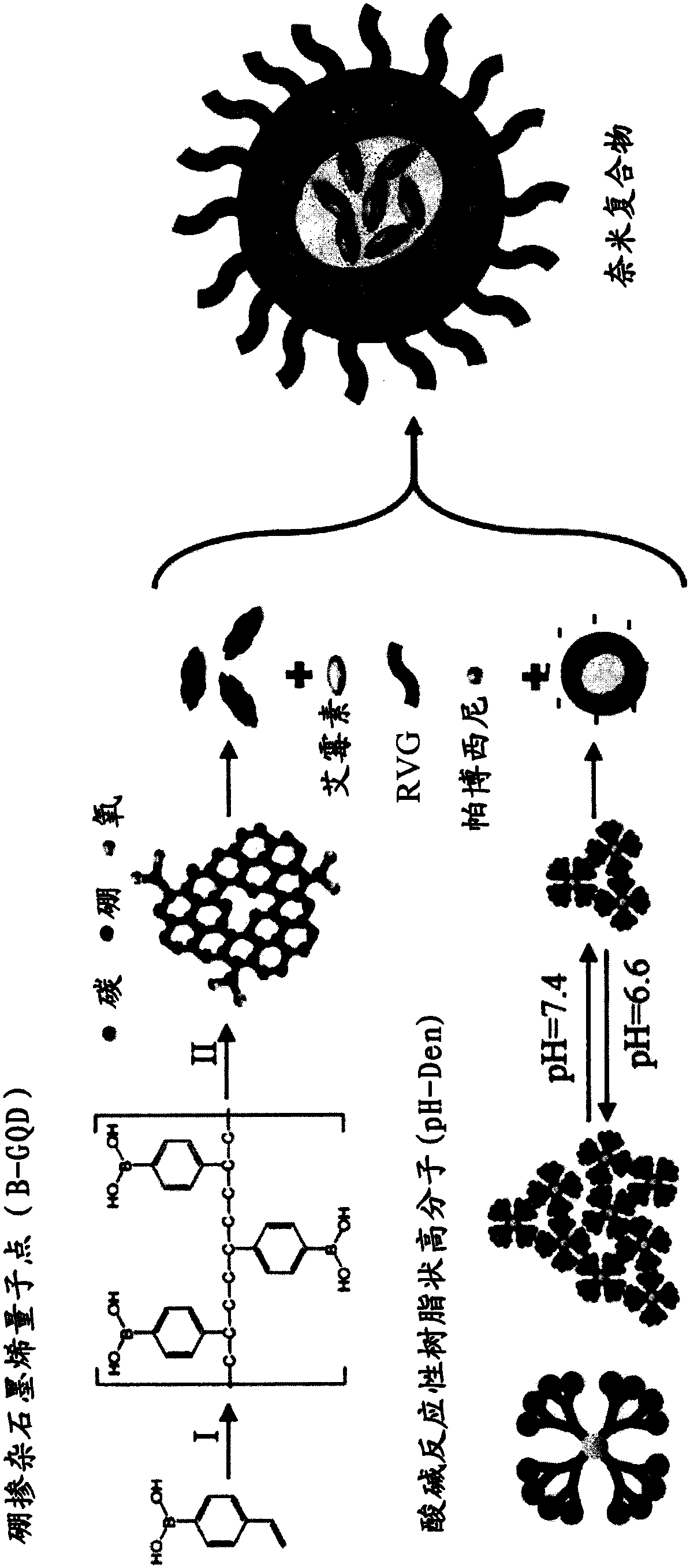Nanocomposite containing boron-doped graphene quantum dots and application thereof
A technology of graphene quantum dots and composites, which is applied in the field of nanocarriers, can solve the problems of limited visible light penetration and cannot be used to treat deep tumors or brain tumors, achieve uniform tumor treatment effects, avoid toxic and side effects, and improve The effect of the treatment effect
- Summary
- Abstract
- Description
- Claims
- Application Information
AI Technical Summary
Problems solved by technology
Method used
Image
Examples
Embodiment 1
[0049] Preparation of boron-doped graphene quantum dots
[0050] This example illustrates the preparation method of the main constituent molecules of the nanocomposite of the present invention, that is, boron-doped graphene quantum dots (B-GQD for short). 75 mg of 4-vinylphenylboronic acid and 150 mg of boric acid were dissolved in a mixed solution of 2.5 mL of ethanol and 15 mL of acetone. After 0.5 to 1 hour of sonication, slowly add 2.5 mL of 30% hydrogen peroxide. The obtained mixed solution is subjected to ultrasonic vibration for 10 minutes and then reacted at 150 to 400° C. for 2 to 48 hours to obtain a crude product of boron-doped graphene quantum dots. The crude product was then inserted into a dialysis membrane with a molecular weight cut-off of 1000 Da (OrDial D-ClearDialysis Membranes MWCO: 1000; Orange Scientific) and dialyzed against deionized water for three days at room temperature, and the water was changed once a day. The boron-doped graphene quantum dots a...
Embodiment 2
[0052] Preparation of nanocomposites
[0053] 2.1 Preparation of acid-base reactive dendrimers
[0054] The nanocomplexes of the present invention preferably comprise stimuli-responsive polymer molecules that can expand the volume of the nanocomplexes in a tumor environment, such as in the mildly acidic environment of a tumor (about pH 6.5-7.0). In this example, an acid-base-reactive dendrimer (referred to as pH-Den) with a molecular weight of 1,000 to 60,000 Da is used as an example to illustrate the preparation method of the stimuli-responsive polymer molecule. 4.4 mg of 4-(bromomethyl) Phenylboronic acid and 100 mg of the second-generation polyethylene diamine dendrimers were dissolved in dimethyl sulfoxide, and reacted at 80 °C for 24 hours to obtain phenylboronic acid-modified polyethylene diamine dendrimers (PBA-PAMAM). ), which is an example of an acid-base reactive dendrimer. After cooling, the crude product was placed on a dialysis membrane with a molecular weight c...
Embodiment 3
[0061] Structure and Properties of Nanocomposites
[0062] In order to examine the structure and properties of the nanocomposite of the present invention, the boron-doped graphene quantum dots / acid-base reactive dendrimer nanocomposite described in Example 2.2 was observed by a transmission electron microscope (TEM). and the shape and behavior of its constituent units. Figure 2A TEM image showing boron-doped graphene quantum dots; Figure 2B A TEM image of a phenylboronic acid-modified polyethylenediamine dendrimer (an example of an acid-base reactive dendrimer) is shown. in accordance with Figure 2A , the boron-doped graphene quantum dots will aggregate into clusters in water, and the particle size of each quantum dot is about 2 to 5 nm. in accordance with Figure 2B , the acid-base-reactive dendrimers self-assemble into spheres in water with a particle size of about 50 to 80 nm. Figure 2A and Figure 2B It is proved that boron-doped graphene quantum dots and phenylb...
PUM
| Property | Measurement | Unit |
|---|---|---|
| Particle size | aaaaa | aaaaa |
| Particle size | aaaaa | aaaaa |
| Particle size | aaaaa | aaaaa |
Abstract
Description
Claims
Application Information
 Login to View More
Login to View More - R&D
- Intellectual Property
- Life Sciences
- Materials
- Tech Scout
- Unparalleled Data Quality
- Higher Quality Content
- 60% Fewer Hallucinations
Browse by: Latest US Patents, China's latest patents, Technical Efficacy Thesaurus, Application Domain, Technology Topic, Popular Technical Reports.
© 2025 PatSnap. All rights reserved.Legal|Privacy policy|Modern Slavery Act Transparency Statement|Sitemap|About US| Contact US: help@patsnap.com



